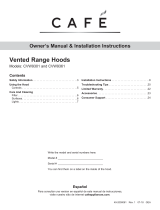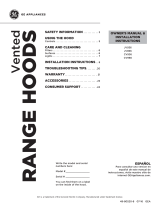
6 49-2000061 Rev. 2
Be sure the circuit breaker is off and all surfaces are cool before cleaning or servicing any part of the vent hood.
Reusable Metal Grease Filters
The hood has 2 metal reusable grease filters.
The metal filters trap grease released by foods on the
cooktop. They also help prevent flaming foods on the
cooktop from damaging the inside of the hood.
For this reason, the filters must ALWAYS be in place
when the hood is used. The grease filters should be
cleaned once a month, or as needed.
To clean the grease filters, soak them and then swish
them around in hot water and detergent. Don’t use
ammonia or ammonia products because they will darken
the metal. Do not use abrasives or oven cleaners. Light
brushing can be used to remove embedded dirt. Rinse,
shake and let them dry before replacing.
To remove:
Grasp the filter handle and pull it up, forward and out.
To replace:
1. Hold the filter at the
bottom with the handle.
2. Place the top end of the
filter against the inside
front of the hood.
3. Slide it up until it stops
and push the bottom
end back until it snaps
into place.
Filter
CARE AND CLEANING: Filter / Surfaces
Stainless Steel Surfaces (on some models)
Do not use a steel wool pad; it will scratch the
surface.
To clean the stainless steel surface, use warm sudsy
water or a stainless steel cleaner or polish. Always wipe
the surface in the direction of the brush line. Follow
the cleaner instructions for cleaning the stainless steel
surface. Cleaners with oxalic acid such as Bar Keepers
Friend Soft Cleanser™ will
remove surface rust, tarnish, and
small blemishes. To receive a
$2.00 coupon for a trial sample
of Bar Keepers Friend Soft
Cleanser™ follow the link below
or scan the QR Code.
www.barkeepersfriend.com/ge
Use only a liquid cleanser free of grit and rub in the
direction of the brush lines with a damp soft sponge.
To inquire about purchasing stainless steel appliance
cleaner or polish, or to find the location of a dealer
nearest you, visit cafeappliances.com/parts.
Painted Surfaces (on some models)
Do not use a steel wool pads or other abrasive
cleaners; they will scratch the surface.
Clean grease-laden surfaces of the hood frequently. To
clean the hood surface, use a hot, damp cloth with a
mild detergent suitable for painted surfaces. About one
tablespoon of ammonia may be added to the water. Use
a clean, hot, damp cloth to remove soap. Dry with a dry,
clean cloth.
NOTE: When cleaning, take care not to come in contact
with filters and other surfaces.
CAUTION
When cleaning the hood surfaces,
be certain that you do not touch the light with moist
hands or cloth. A warm or hot light may break if
touched with a moist surface. Always let the light
cool completely before cleaning around it.
Surfaces























